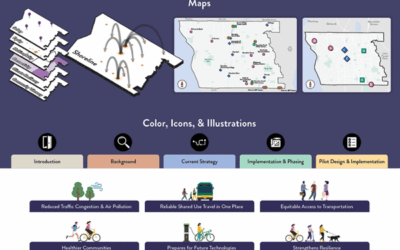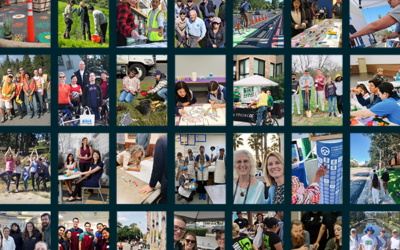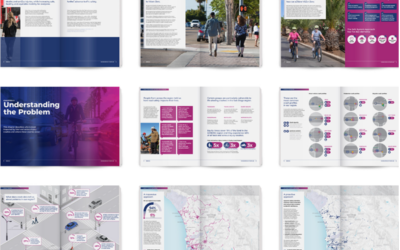
Even though separate investigations around the topics of transportation, equity, and climate resilience are more commonplace, there is a gap in research that intersects these three themes. In a collaborative effort between our Equity and Climate Technical Initiatives (TIs), we explored the dynamics of various interferences in the realm of transportation equity.
What’s Happening
Natural Hazards
During and after natural hazards, vulnerable populations are more likely to be affected by the hazard and less likely to recover quickly or fully from the impacts due to the inequitable resources available.
Extreme heat causes more deaths than any other weather-related hazards. Lower-income areas with fewer amenities, such as park and tree coverage, often experience higher temperatures due to the microclimate. Low-income individuals who are more likely to rely on walking, biking, and transit are also more likely to experience exposure to extreme heat while using these transportation systems. Creating a pedestrian network of shaded corridors and cooler materials for sidewalks to transit stops becomes crucial for transportation access during extreme heat. Transit vehicles and transit stations may be able to serve as additional resources to ensure cooling centers are distributed and accessible – within walking distance – to all residents of a community. Distributed energy production can help support the electricity needs for these cooling centers.
While transportation infrastructure may serve as shoreline protection against sea level rise and storm events, permanent asset damage or temporary shutdown of transportation access among vulnerable populations can have significant, compounding socioeconomic impacts. Understanding the most at-risk coastal transportation infrastructure and the network effects of an outage, balanced against the ongoing cost of maintaining public infrastructure, can help inform long-term investment strategies alongside traditional cost/benefit analyses.
Pandemic
Human Activities & Policies
Across the world, we have seen streets filled with demonstrations against inequalities: people have protested against police brutality in the United States, students have demanded safer streets in Bangladesh, and a 4 percent fare hike ignited mass protests against years of unjust oppression in Chile. These demonstrations are calling attention to concerns about long-standing historical and structural racism and inequality, and in occupying our transportation networks, also serve to highlight the connection between these issues and transportation planning.
From inadequacy in traditional transportation service (poor transit network coverage, insufficient transit amenities, unreliable service, security issues) to an imbalanced rollout of higher-cost disruptive trends (services that direct private and public resources to wealthier, “market-ready” neighborhoods while structurally excluding under-resourced populations by requiring smartphones or credit cards), inequalities in transportation often limit opportunities for people who need them the most.
What Tools Do We Have?
Visioning
While working on transportation planning and engineering projects, we are hearing big questions from our clients that will affect how vulnerable populations are incorporated into equitable adaptation planning for transportation systems. Taking these questions into account assists in preparing for more equitable, longer-lasting plans.
-
-
-
-
-
-
-
-
- How should we prioritize access to evacuation routes for groups?
- How cost effective are climate adaptation strategies, and who benefits from them?
- How should jurisdictions decide which assets should be maintained with limited public funds, and what are the opportunity costs of doing so?
-
-
-
-
-
-
-
Analysis
While working on transportation planning and engineering projects, we are hearing big questions from our clients that will affect how vulnerable populations are incorporated into equitable adaptation planning for transportation systems. Taking these questions into account assists in preparing for more equitable, longer-lasting plans.
-
-
-
-
-
-
-
-
-
-
- How should we prioritize access to evacuation routes for groups?
- How cost effective are climate adaptation strategies, and who benefits from them?
- How should jurisdictions decide which assets should be maintained with limited public funds, and what are the opportunity costs of doing so?
-
-
-
-
-
-
-
-
-
What Are the Best Practices for Developing Equitable Climate
-
-
- Prepare for the long haul rather than only reactive or emergency measures.
- Identify and integrate core community values in the framework that specify which groups may need the most support during and after a disruption.
- Plan for various groups, including low-income, minorities, non-English speakers, people with disabilities or reduced mobility, senior citizens, etc., and embed analysis processes that ensure the needs of these groups have been considered.
- Incorporate critical community engagement in addition to a data-driven approach, in order to fill in the gaps where data fails and capture the whole story.
- Adopt an “all hazards” approach for all modes of transportation, which considers disruptions of all kinds, including more traditional disaster preparedness planning alongside climate adaptation planning.
- Incorporate equitable prioritization of transportation investments to support long-term climate adaptation and resilience, which may require challenging the status quo.
- Be cognizant about encouraging recovery efforts that may displace disadvantaged communities and consider better alternatives.
- Focus on collaborative planning across sectors and departments.
-
Explore More
Mobility Hubs for Everyone
We partnered with the City of Shoreline to bring shared-use mobility hubs to life through visual storytelling—making sustainable, people-first travel easier to understand, support, and implement.
Celebrating 40 Years of Moving Communities Forward
In 1985, Juergen Fehr and Jack Peers set out to build a different kind of transportation consulting firm—one that empowered its people and focused on improving communities through innovation and creativity.
Designing for a Bold Vision: Vision Zero
It was great to support their team in shaping the plan’s structure and story, helping visually communicate priorities and chart a clear path for action.







